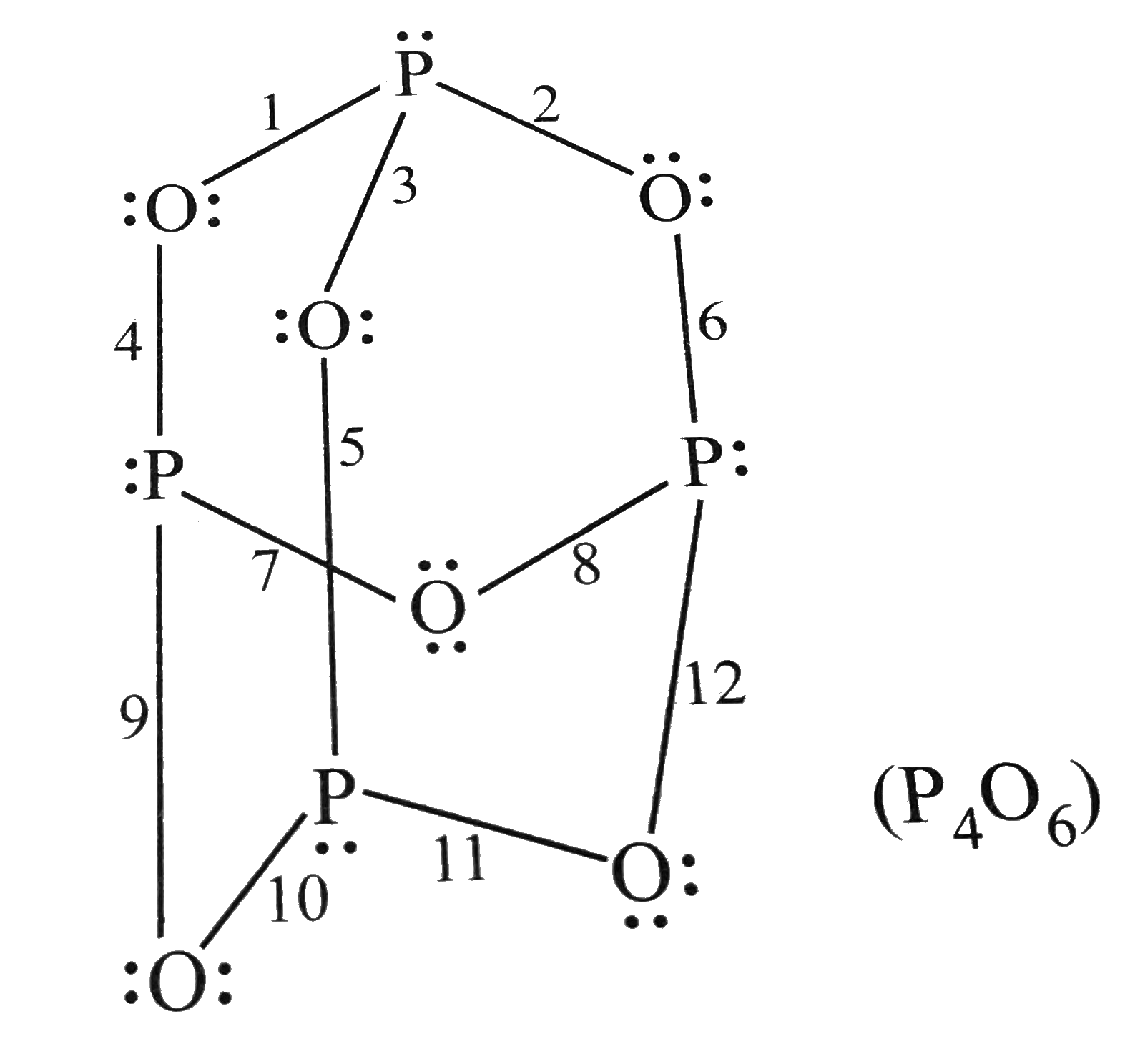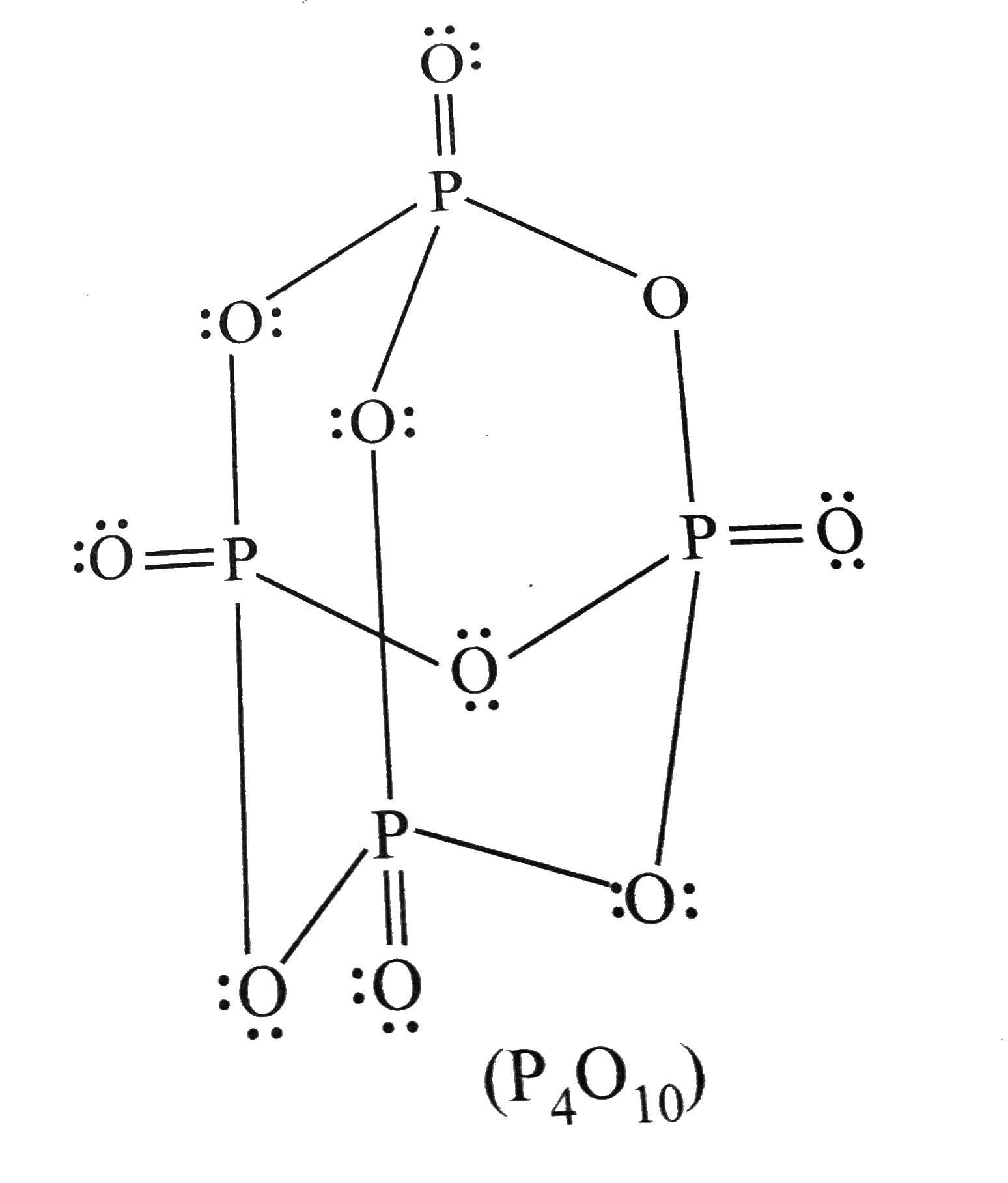Answer the following
(a) How many σ,π non - bonding electrons present in
(i) P4O6 (ii) P4O10
(b) Which of the following are isostructural and isocelectonic ?
NO3,CO2−3,CIOΘ3,SO3
(c ) Why CO2 and SO2 are not isostructural ?
(d) Why PCI5 dissociate to give PCI3 and CI4 whereas SF6 does not dissociate to give SF4 and F2 on heating ?
(e) Discuss the shapes of molecular orbitals formed by the combination of the following atomic orbitals
(i) 2pz and 2pz (ii) 2px and 2px
(f) Why IF7 dissociate to give IF2+52F2 not IF2+F2 Expalin
(g) Why axial bonds of PCI5 are longer than equatorial bonds ?
(h) BHΘ4 and ⊕NH4 are isolobal Explain
(i) Name the anion which is isostructural with BF3 (j) Name the cation which is isostructural with CH4
(k) Which of the following alkali metal chlorides is expected th have the highest melting point
(i) LiCI (ii) KCI (iii) RbCI (iv) NaCI .
Text Solution
σ bonds =12
π bond = Zero
Each P has 1 lp of e−'s
Four P ahs 4lp's=8 non-bonding e−s
Each O-atom has 2lp'sofe−'s=32
σ bonds =12+4=16
π bond = 4
P-atom does not have lp's of e−'s
The O-atom has 2×10=20lp's=40 non-bonding
e−'s
(b) NOΘ3 and CO2−3 are isoelectronic and isostructural
Number of e−'s in NOΘ3=7+24+1=32
Number of e−'s in CO2−3=6+24+2=32
Hence they are isoelectronic
Therefore, hybridisation of central atom is both cases is sp2 Hence they are isotructural also
(c )C in CO2 is sp hybridised and is linear S in SO2 in sp2 hybridised and is bent molecule
(d)PCI5 and refer to Section 2.21 (5) for SF6
(h) Both are sp3 hybridised and have tetrahedral shape
(i) NOΘ3 (Triangular planar)
(j) ⊕NH4 (Tetrahedral)
(k) Lattice energey (ΔUHΘ) decrease down the group (⏐↓) . Although ΔUHΘ of LiCI is higher than that of NaCI but LiCI is covalent and NaCI is ionic in nature After NaCIΔUHΘ decreases as the size of alkali metal ion increases As melting point depends upon lattice energy and ionic/covalent nature of the compounds thus naCI has the highest melting point .

 .
.
|
Topper's Solved these Questions
- CHEMICAL BONDING AND MOLECULAR STRUCTUREBOOK - CENGAGE CHEMISTRYCHAPTER - CHEMICAL BONDING AND MOLECULAR STRUCTUREEXERCISE - Ex 2 .2 Subjective (Intermolecular Forces And H-Bonding)
7 Videos
- CHEMICAL BONDING AND MOLECULAR STRUCTUREBOOK - CENGAGE CHEMISTRYCHAPTER - CHEMICAL BONDING AND MOLECULAR STRUCTUREEXERCISE - Ex 2 .2 Subjective (Molecular Orbital Theory)
4 Videos
- CHEMICAL BONDING AND MOLECULAR STRUCTUREBOOK - CENGAGE CHEMISTRYCHAPTER - CHEMICAL BONDING AND MOLECULAR STRUCTUREEXERCISE - Archives Subjective
15 Videos
- ATOMIC STRUCTUREBOOK - CENGAGE CHEMISTRYCHAPTER - ATOMIC STRUCTUREEXERCISE - Concept Applicationexercise(4.3)
19 Videos
- CHEMICAL EQUILIBRIUMBOOK - CENGAGE CHEMISTRYCHAPTER - CHEMICAL EQUILIBRIUMEXERCISE - Archives (Subjective)
11 Videos
Similar Questions
Knowledge Check
Which of the following are isoelectronics and isostructural ?
ANO−3,CO2−3BSO3,NO−3CClO−3,CO2−3DCO2−3,ClO−3Which of the following are isoelectronic and isostructural ?
NO−3,CO2−3,ClO−3,SO3ANO−3,CO2−3BSO3,NO−3CClO3,CO2−3DCO2−3,SO3Which of the following are isolectronic and iso-structural ?
NOΘ3 ,CO2−3, CIOΘ3 ,SO3 .ACO2−3,CIOΘ3BCO2−3,NOΘ3CSO3,CO2−3DSO3,NOΘ3
How many of the following compounds violate octet rule
(i) BrF5 (ii) SF6 (iii) IF7 (iv) XeOF4
(v) CIF2 (vi) PCI⊕4 .
View SolutionHow many of the following compounds violate octet rule
(i) BrF5 (ii) SF6 (iii) IF7 (iv) XeOF4
(v) CIF2 (vi) PCI⊕4 .
View SolutionWhich of the following are isoelectronic and isostructural? NO−3,CO2−3,ClO−3,SO3
View SolutionWhich of the following compounds do not exist?
N4, P4, PCI5, NCI3, P2O5 ,NO2, PO2
View SolutionWhich of he following are isostructural ?
NO−2,CO2−3,ClO−3,SO3,XeO3,(I)(II)(III)(IV)(V)
View Solution
